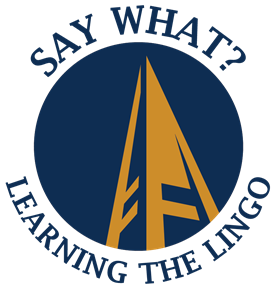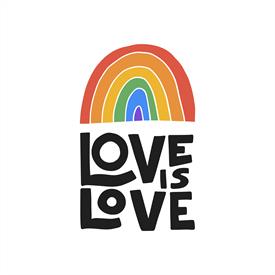 Learning, of course, is the goal of any college experience. Part of that education means familiarizing yourself with new and unfamiliar terms. Don’t worry, we’ve got you covered.
Learning, of course, is the goal of any college experience. Part of that education means familiarizing yourself with new and unfamiliar terms. Don’t worry, we’ve got you covered.
As part of our “Say What?” series, we’ll explain phrases, lingo or topics to add to your college vocabulary. If there’s a topic you’d like to see covered, please send suggestions to communications@schoolcraft.edu.
For this installment, we’re celebrating Pride Month by providing definitions and context for the language used to discuss sexual identity and gender orientation.
For many people, these are difficult topics to discuss because they are afraid to use the wrong term, or to offend someone by making assumptions. The LGBTQ+ community is diverse, including people of all ages and from all walks of life.
As such, the definitions and explanations below may not be universal. Even though someone may fit the generally used definition of one of these terms, they may not personally identify this way. It’s always best to ask – and listen – to how a person refers to themselves.
Ally: A term used to describe someone who is actively supportive of LGBTQ people. It encompasses straight and cisgender (see below) allies, as well as those within the LGBTQ community who support each other (e.g., a lesbian who is an ally to the bisexual community).
Cisgender: A term used to describe a person whose gender identity aligns with those typically associated with the sex assigned to them at birth.
Gay: The adjective used to describe people whose enduring physical, romantic, and/or emotional attractions are to people of the same sex (e.g., gay man, gay people). Sometimes lesbian (n. or adj.) is the preferred term for women.
Gender Expression: External manifestations of gender, expressed through a person's name, pronouns, clothing, haircut, behavior, voice and/or body characteristics. Society identifies these cues as masculine and feminine, although what is considered masculine or feminine changes over time and varies by culture. Typically, transgender people seek to align their gender expression with their gender identity, rather than the sex they were assigned at birth.
Gender-Fluid: A person who does not identify with a single fixed gender or has a fluid or unfixed gender identity.
Gender Identity: A person's internal, deeply held sense of their gender. For transgender people, their own internal gender identity does not match the sex they were assigned at birth. Most people have a gender identity of man or woman (or boy or girl). For some people, their gender identity does not fit neatly into one of those two choices.
Lesbian: A woman whose enduring physical, romantic, and/or emotional attraction is to other women. Some lesbians may prefer to identify as gay (adj.) or as gay women.
LGBTQ+: Acronym for lesbian, gay, bisexual, transgender and queer. Sometimes, when the Q is seen at the end of LGBT, it can also mean questioning. LGBT and/or GLBT are also often used.

Bisexual: A person who has the capacity to form enduring physical, romantic and/or emotional attractions to those of the same gender or to those of another gender.
Non-binary: Terms used by some people who experience their gender identity and/or gender expression as falling outside the categories of man and woman. They may define their gender as falling somewhere in between man and woman, or they may define it as wholly different from these terms. The term is not a synonym for transgender or transsexual and should only be used if someone self-identifies as non-binary and/or genderqueer.
Pansexual: Describes someone who has the potential for emotional, romantic or sexual attraction to people of any gender though not necessarily simultaneously, in the same way or to the same degree. Sometimes used interchangeably with bisexual.
Pronouns: LGBTQ+ individuals should be identified with their correct pronouns. Often, this is the pronoun that corresponds with their gender identity. Some transgender and non-binary people do not identify with the gender binary and prefer not to use pronouns typically associated with men (he/him) or women (she/her). Instead, they may prefer if people simply use their names, use gender neutral pronouns such as “they/them” or use other pronouns such as “fae/faer” or “ey/em.” Not sure which to use? It’s appropriate to respectfully ask for a person’s name and pronouns. You also could share your pronouns to create an opportunity for the other person to share theirs.
Queer: An adjective used by some people, particularly younger people, whose sexual orientation is not exclusively heterosexual. Once considered a pejorative term, queer has been reclaimed by some LGBT people to describe themselves; however, it is not a universally accepted term even within the LGBT community. When Q is seen at the end of LGBT, it typically means queer and, less often, questioning.
Questioning: A term used to describe people who are in the process of exploring their sexual orientation or gender identity.
Sex: The classification of a person as male or female. At birth, infants are assigned a sex, usually based on the appearance of their external anatomy. (This is what is written on the birth certificate.) A person's sex, however, is actually a combination of bodily characteristics including: chromosomes, hormones, internal and external reproductive organs, and secondary sex characteristics.
Sexual Orientation: The scientifically accurate term for an individual's enduring physical, romantic and/ or emotional attraction to members of the same and/or opposite sex, including lesbian, gay, bisexual, and heterosexual (straight) orientations.
Transgender: An umbrella term for people whose gender identity differs from the sex they were assigned at birth. People under the transgender umbrella may describe themselves using one or more of a wide variety of terms - including transgender.
Transition: Altering one's birth sex is not a one-step procedure; it is a complex process that occurs over a long period of time. Transition can include some or all of the following personal, medical, and legal steps: telling one's family, friends, and co-workers; using a different name and new pronouns; dressing differently; changing one's name and/or sex on legal documents; hormone therapy; and possibly (though not always) one or more types of surgery. The exact steps involved in transition vary from person to person.
These definitions were sourced from helpful glossaries created by the Human Rights Council and GLAAD; more information is available on these sites.